hood open CHEVROLET TAHOE 1996 1.G Owners Manual
[x] Cancel search | Manufacturer: CHEVROLET, Model Year: 1996, Model line: TAHOE, Model: CHEVROLET TAHOE 1996 1.GPages: 403, PDF Size: 20.63 MB
Page 76 of 403
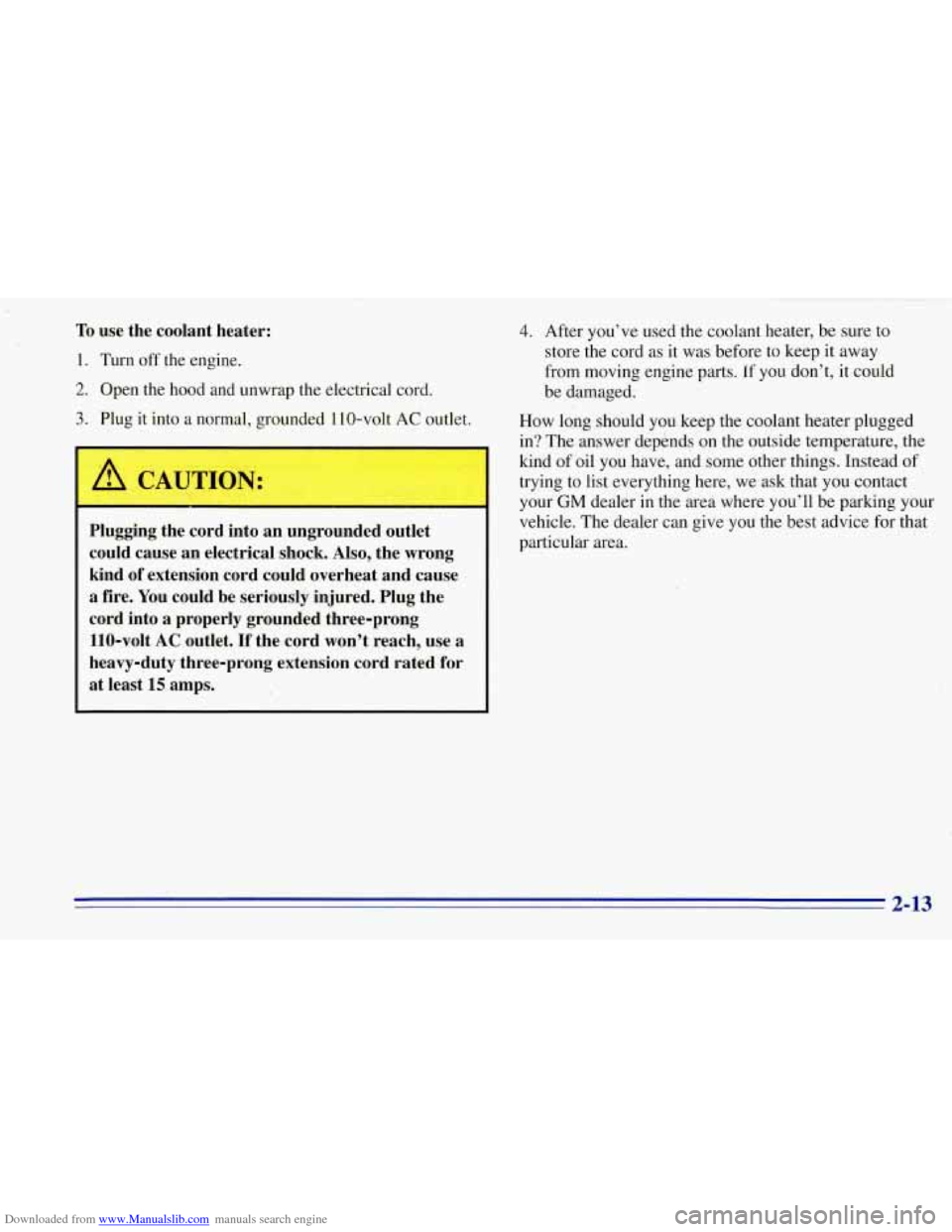
Downloaded from www.Manualslib.com manuals search engine To use the coolant heater:
1. Turn off the engine.
2. Open the hood and unwrap the electrical cord.
3. Plug it into a normal, grounded 110-volt AC outlet.
4 CAUTION:
Plugging the cord into an ungrounded outlet
could cause an electrical shock. Also, the wrong
kind
of extension cord could overheat and cause
a fire. You could be seriously injured. Plug the
cord into
a properly grounded three-prong
110-volt
AC outlet. If the cord won’t reach, use ,a
heavy-duty three-prong extension cord rated
for
at least 15 amps.
4. After you’ve used the coolant heater, be sure to
store the cord as it was before to keep it away
from moving engine parts.
If you don’t, it could .@
be damaged.
How long should you keep the coolant heater plugged
in? The answer depknds
on the outside temperature, the
kind
of oil you have, and some other things. Instead of
trying to list everything here, we ask that you contact
your
GM dealer in the area where you’ll be parking your
vehicle. The dealer can give you the best advice for that
particular area.
Page 110 of 403
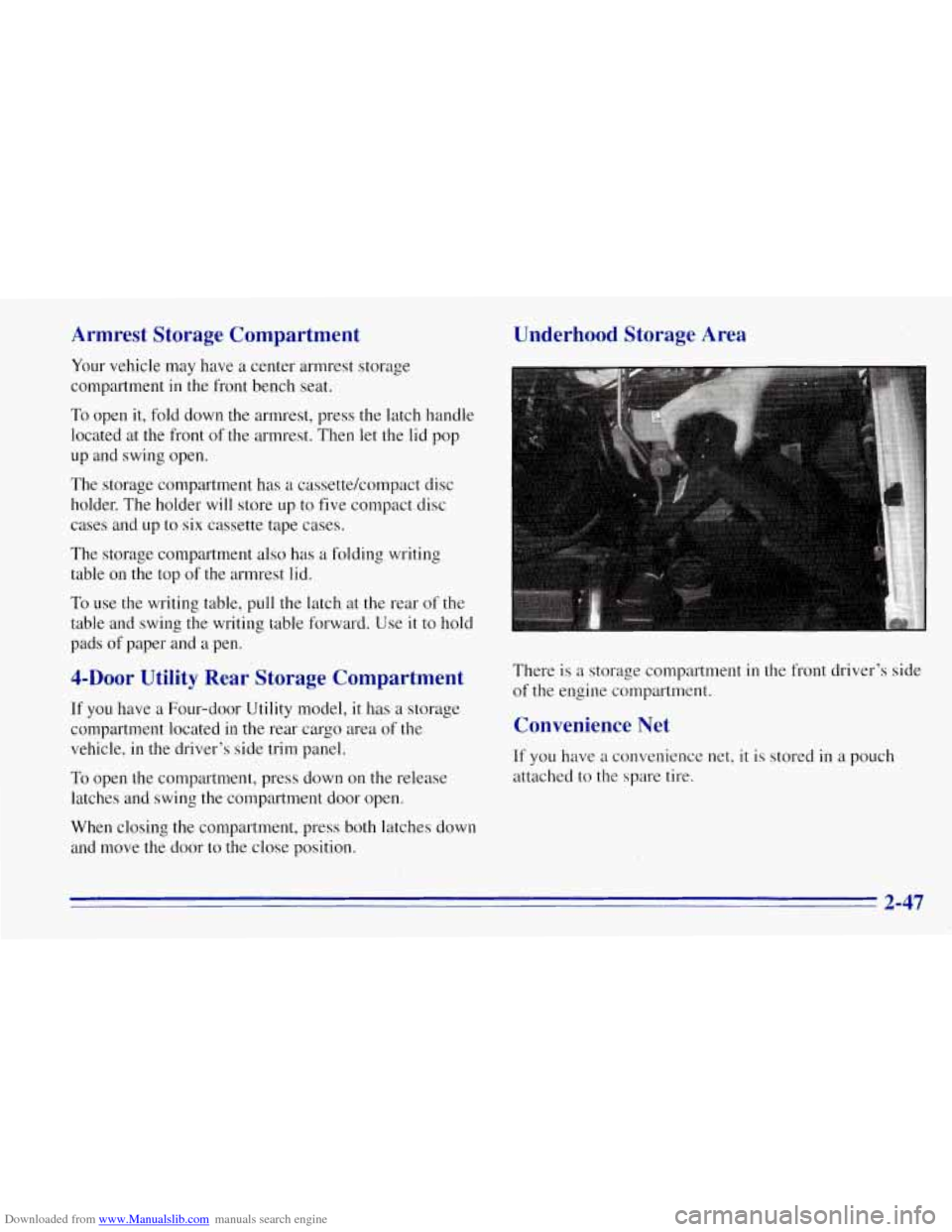
Downloaded from www.Manualslib.com manuals search engine Armrest Storage Compartment
Your vehicle may have a center armrest storage
compartment
in the front bench seat.
To open it, fold down the armrest, press the latch handle
located at the front of the armrest. Then let the lid pop
up and swing open.
The storage compartment has a cassettekompact disc
holder. The holder will store up to five compact disc
cases and up to six cassette tape cases.
The storage compartment
also has a folding writing
table on the top of the armrest lid.
To use the writing table, pull the latch at the rear of the
table and swing the writing table forward. Use it to hold
pads of paper and
a pen.
$-Door Utility Rear Storage Compartment
If you have a Four-door Utility model, it has a storage
compartment located in the rear cargo area of the
vehicle, in the driver’s side trim panel.
To open the compartment, press down on the release
latches and swing the compartment door open.
When closing the compartment, press both latches down
and move the door to the close position.
Underhood Storage Area
There is a storage compartment in the front driver’s side
of the engine compartment.
Convenience Net
If you have a convenience net, it is stored in a pouch
attached to the spare tire.
2-47
Page 139 of 403
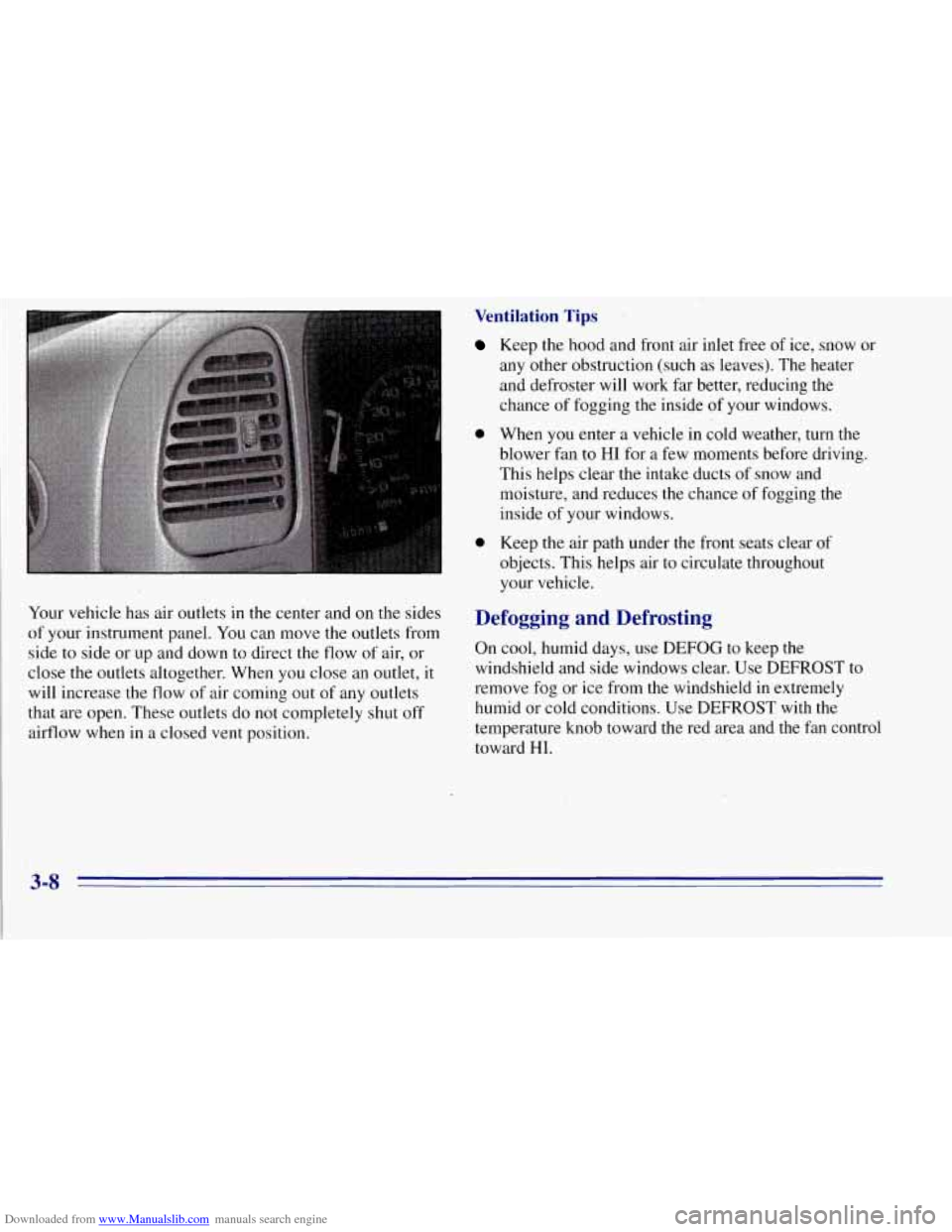
Downloaded from www.Manualslib.com manuals search engine Your vehicle has air outlets in the center and on the sides
of your instrument panel. You can move the outlets from
side to side or up and down to direct the flow
of air, or
close the outlets altogether. When you close an outlet, it
will increase the flow
of air coming out of any outlets
that
are open. These outlets do not completely shut off
airflow when in a closed vent position.
0
0
Ventilation Tips
Keep the hood and front air inlet free of ice, snow or
any other obstruction (such as leaves). The heater
and defroster will work far better, reducing the
chance
of fogging the inside of your windows.
When you enter a vehicle in cold weather, turn the
blower fan to HI for a few moments before driving.
This helps clear the intake ducts of snow and
moisture, and reduces the chance
of fogging the
inside of your windows.
Keep the air path under the front seats clear of
objects. This helps ,air to circulate throughout
your vehicle.
efogging and Defrosting
D
On cool, humid days, use DEFOG to keep the
windshield and side windows clear. Use DEFROST to
remove fog or ice from the windshield in extremely
humid or cold conditions. Use DEFROST with the
temperature knob toward the red area and the fan control
toward HI.
3-8
Page 218 of 403
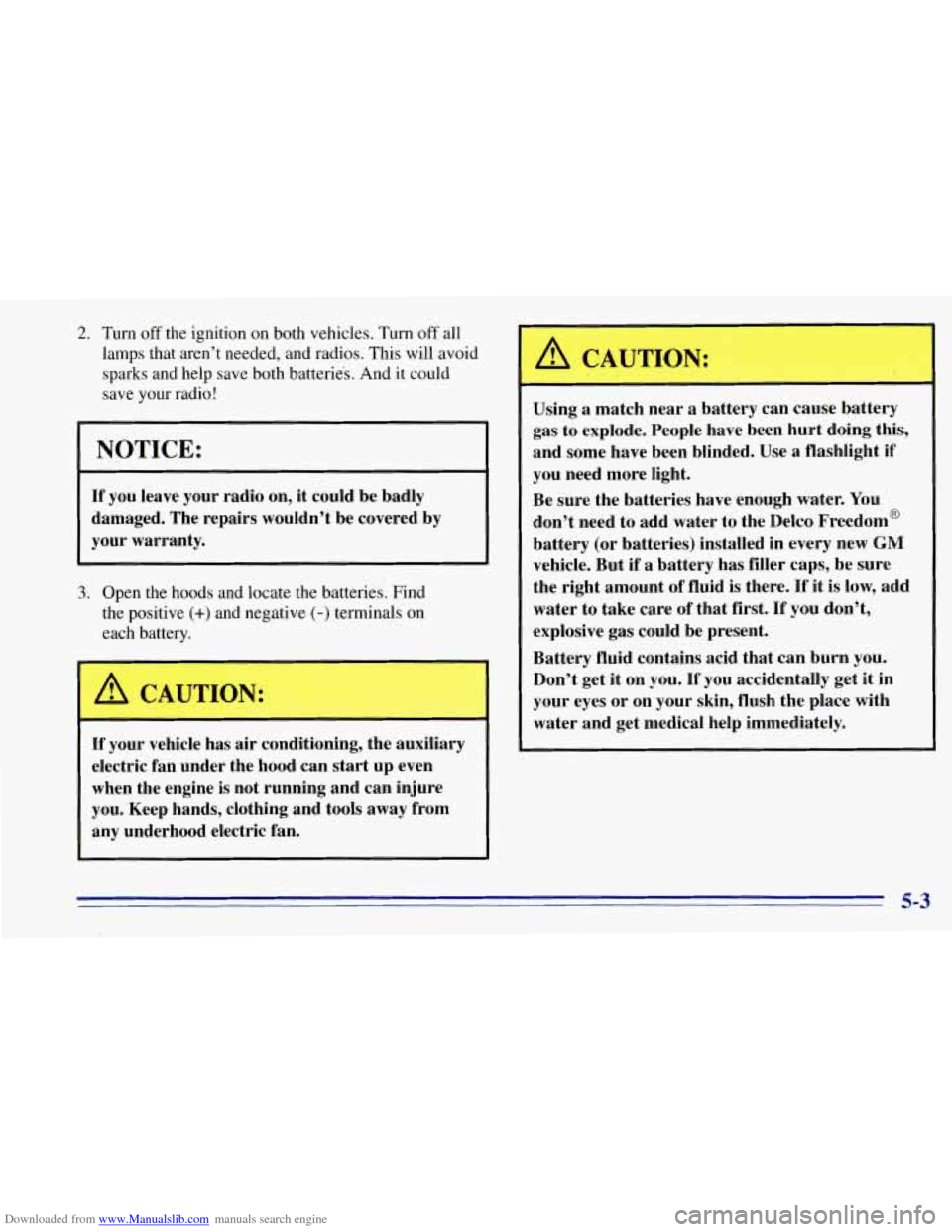
Downloaded from www.Manualslib.com manuals search engine 2. Turn off the ignition on both vehicles. Turn off all
lamps that aren’t needed, and radios. This will avoid
sparks and help save both batteries. And it could
save your radio!
NOTICE: I
If you leave your radio on, it could be badly
damaged. The repairs wouldn’t be covered by
your warranty.
3. Open the hoods and locate the batteries’. Find
the positive
(+) and negative (-) terminals on
each battery.
A CAUTION:
If your vehicle has air conditioning, the auxiliary
electric fan under the hood can start up even
when the engine is not running and can injure
you. Keep hands, clothing and tools away from
any underhood electric fan.
~
A CAUTION:
-
Using a match near a battery can cause battery
gas to explode. People have been hurt doing this,
and some have been blinded. Use a flashlight if
you need more light.
Be sure the batteries have enough water. You
don’t need to add water to the Delco Freedom@
battery (or batteries) installed in every new
GM
vehicle. But if a battery has filler caps, be sure
the right amount of fluid is there.
If it is low, add
water to take care of that first.
If you don’t,
explosive
gas could be present.
Battery fluid contains acid that can burn
you.
Don’t get it on you. If you accidentally get it in
your eyes or on your skin, flush the place with
water and get medical help immediately.
5-3
Page 224 of 403
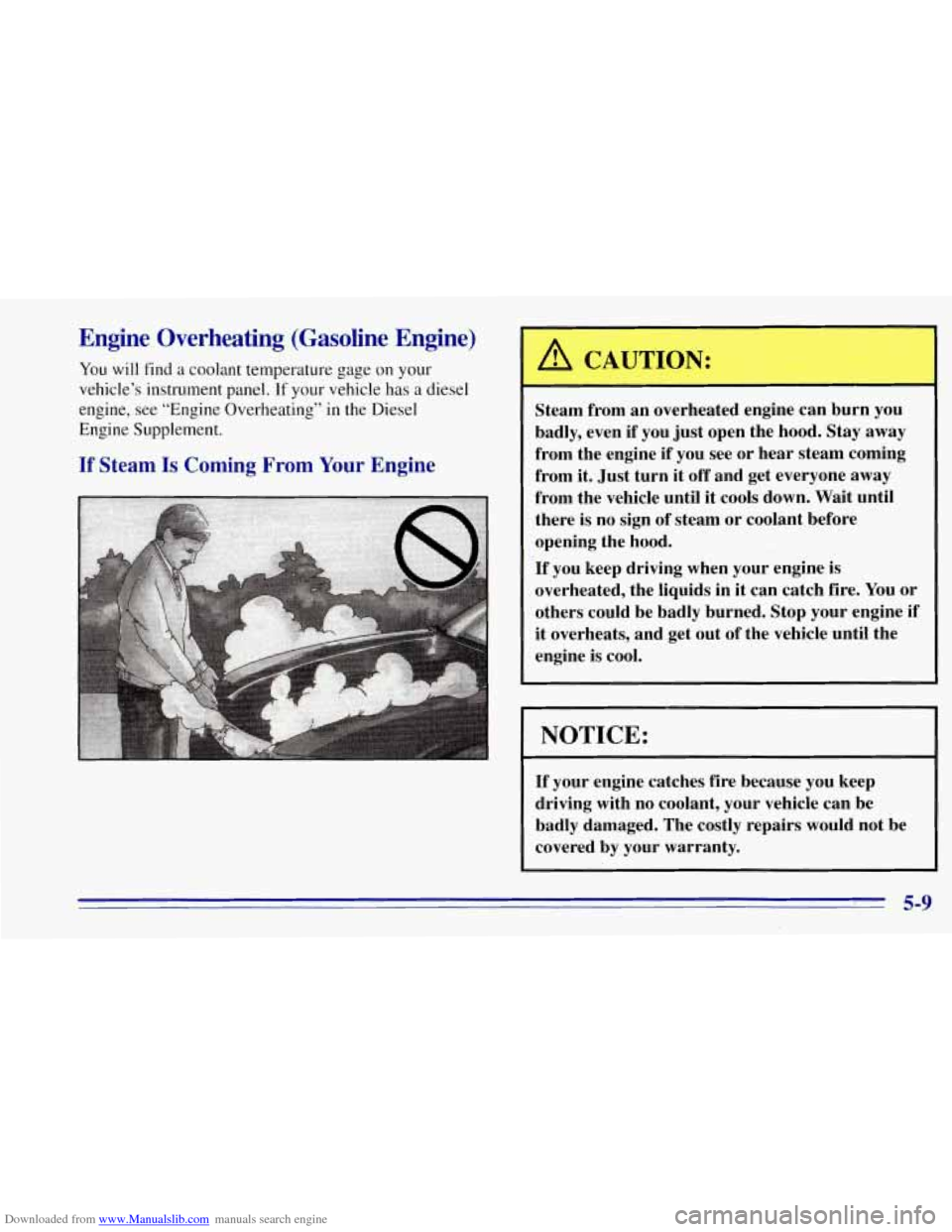
Downloaded from www.Manualslib.com manuals search engine Engine Overheating (Gasoline Engine)
You will find a coolant temperature gage on your
vehicle’s instrument panel. If your vehicle
has a diesel
engine, see “Engine Overheating” in the Diesel
Engine Supplement.
If Steam Is Coming From Your Engine
A CAUTION:
3
Steam from an overheated engine can burn you
badly, even if you just open the hood. Stay
away
from the engine if you see or hear steam coming
from it. Just turn it off and get everyone away
from the vehicle until it cools down. Wait until
there
is no sign of steam or coolant before
opening the hood.
If you keep driving when your engine is
overheated, the liquids in it can catch fire. You or
others could be badly burned. Stop your engine if
it overheats, and get out of the vehicle until the
engine is cool.
I NOTICE:
If your engine catches fire because you keep
driving with no coolant, your vehicle can be
badly damaged. The costly repairs would not be
covered by your warranty.
I 5-9
Page 225 of 403
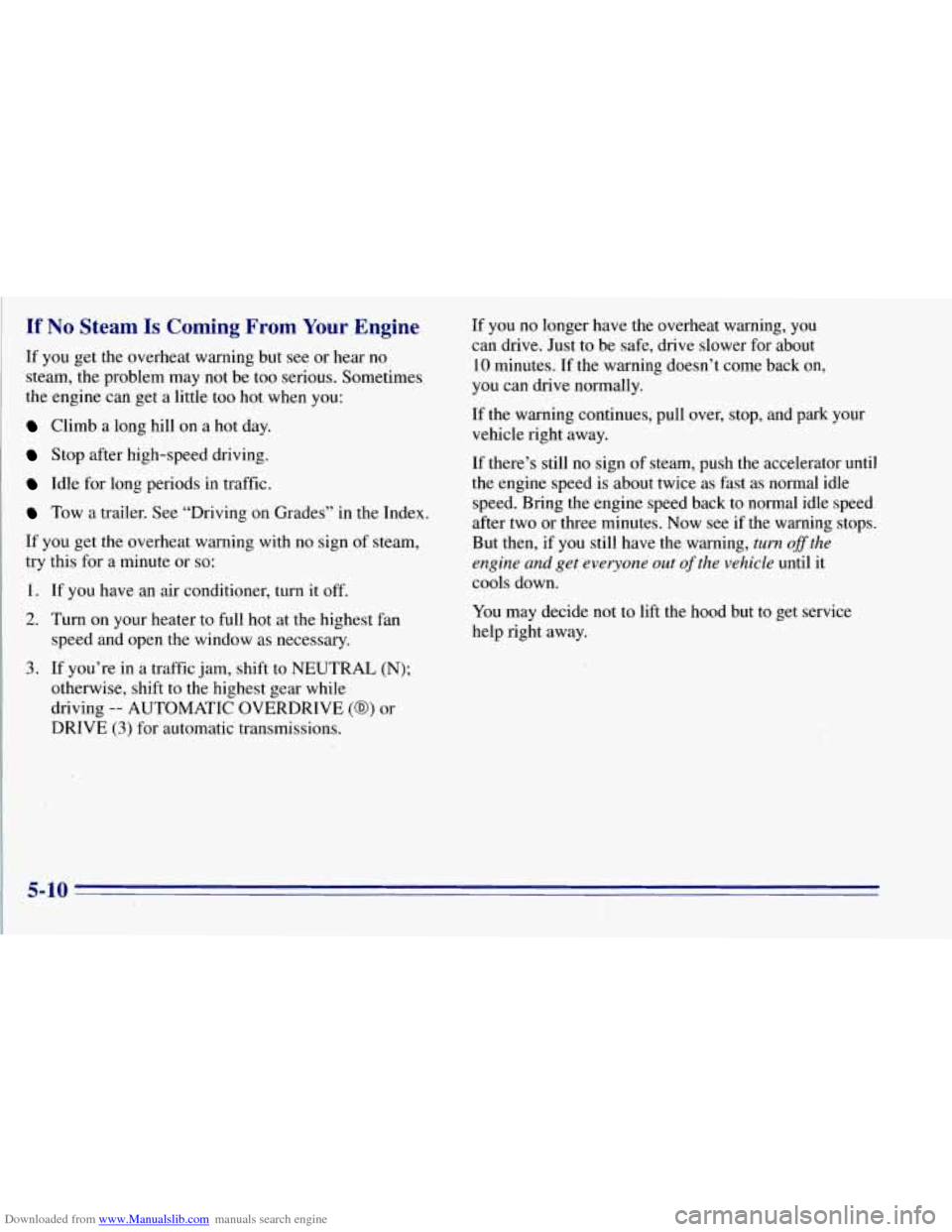
Downloaded from www.Manualslib.com manuals search engine If No Steam Is Coming From Your Engine
If you get the overheat warning but see or hear no
steam, the problem may not be too serious. Sometimes
the engine can get a €ittle too hot when you:
Climb a long hill on a hot day.
Stop after high-’speed driving.
Idle for long periods in traffic.
Tow a trailer. See “Driving on Grades” in the Index.
If you get the overheat warning with no sign of steam,
try this for a minute or
so:
1. If you have an air conditioner, turn it off.
2. Turn on your heater to full hot at the highest fan
speed and open the window as necessary.
3. If you’re in a traffic jam, shift to NEUTRAL (N);
otherwise, shift to the highest gear while
driving
-- AUTOMATIC OVERDRIVE (a) or
DRIVE
(3) for automatic transmissions. If
you no
longer have the overheat warning, you
can drive. Just to be safe, drive slower for about
10 minutes. If the warning doesn’t come back on,
you can drive normally.
If the warning continues, pull over, stop, and park your
vehicle right away.
If there’s still
no sign of steam, push the accelerator until
the engine speed is about twice as fast as normal idle
speed. Bring the engine speed back to normal idle speed
after two or three minutes. Now
see if the warning stops.
But then, if you still have the warning,
turn offthe
engine
and get everyone out of the vehicle until it
cools down.
You may decide not to lift the hood but to get service
help right away.
5-10
Page 260 of 403
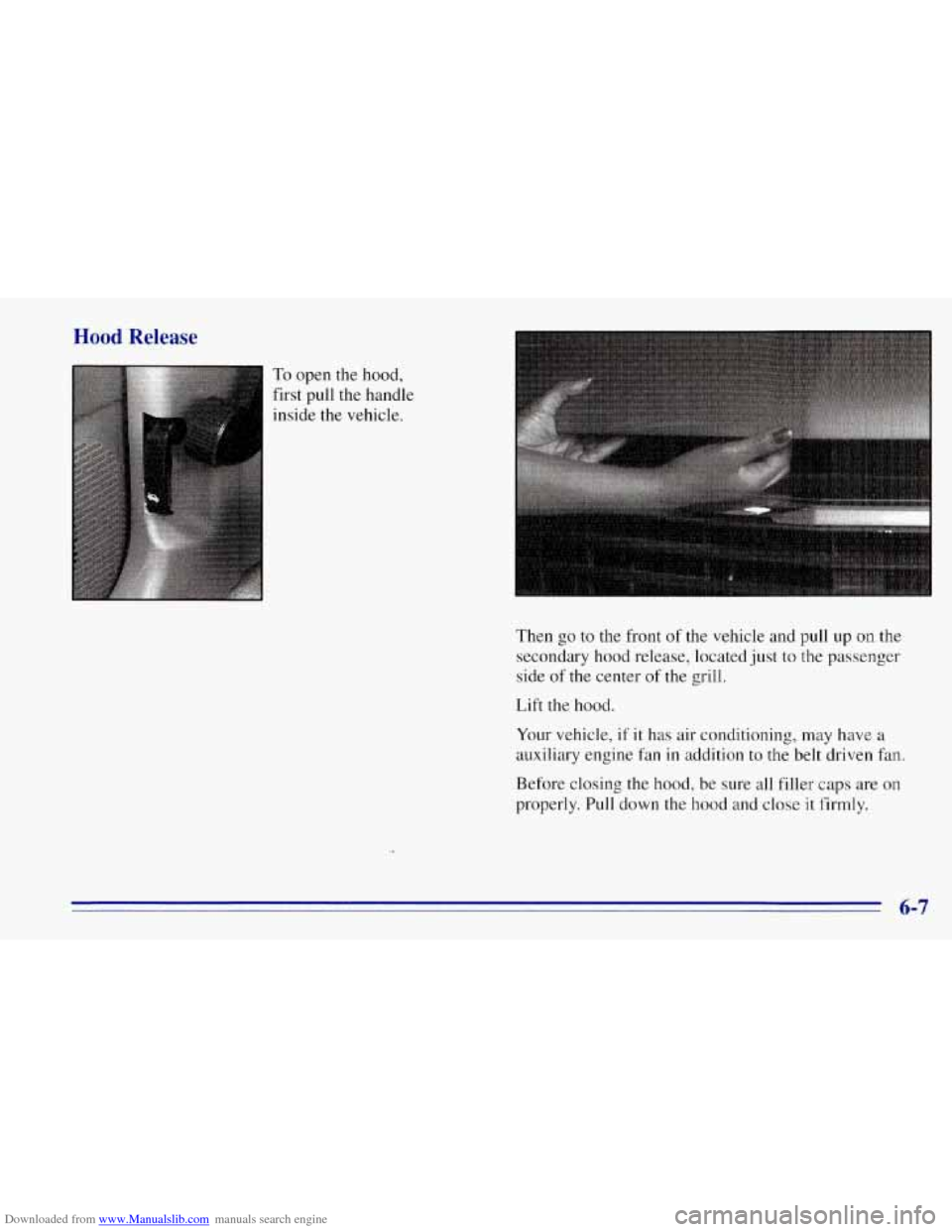
Downloaded from www.Manualslib.com manuals search engine Hood Release
To open the hood,
first pull the handle
inside the vehicle.
.. .
I
Then go to the front of the vehicle and pull up on the
secondary hood release, located just to the passenger
side of the center of the grill.
Lift the hood. Your vehicle,
if it has air conditioning, may have a
auxiliary engine fan in addition to the belt driven
fan.
Before closing the hood, be sure all filler caps are on
properly. Pull down the hood and close it firmly.
6-7
Page 370 of 403
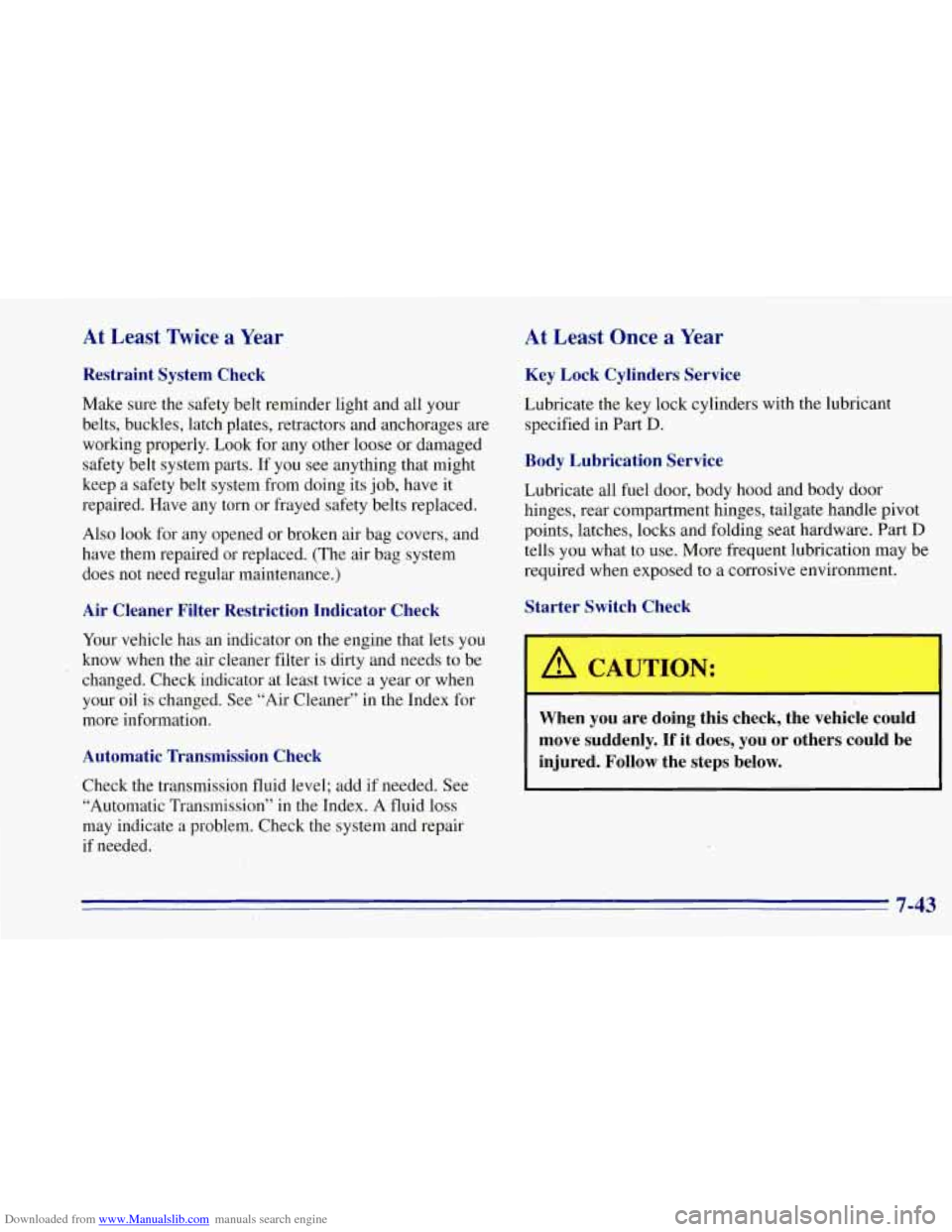
Downloaded from www.Manualslib.com manuals search engine At Least Twice a Year
Restraint System Check
Make sure the safety belt reminder light and all your
belts, buckles, latch plates, retractors and anchorages are
working properly. Look for any other loose or damaged
safety belt system parts.
If you see anything that might
keep a safety belt system from doing its job, have it
repaired. Have any torn or frayed safety belts replaced.
Also look for any opened or broken air bag covers, and
have them repaired or replaced. (The air bag system
does
not need regular maintenance.)
Air Cleaner Filter Restriction Indicator Check
Your vehicle has an indicator on the engine that lets you
know when the air cleaner filter is dirty and needs to be
changed. Check indicator at least twice a year or when
your oil is changed. See “Air Cleaner” in the Index for
more information.
Automatic Transmission Check
Check the transmission fluid level; add if needed. See
“Automatic Transmission”
in the Index. A fluid loss
may indicate a problem. Check the system and repair
if needed.
At Least Once a Year
Key Lock Cylinders Service
Lubricate the key lock cylinders with the lubricant
specified in Part
D.
Body Lubrication Service
Lubricate all fuel door, body hood and body door
hinges, rear compartment hinges, tailgate handle pivot
points, latches, locks and folding seat hardware. Part
D
tells you what to use. More frequent lubrication may be
required when exposed to a corrosive environment.
Starter Switch Check
CAUTION:
When you are doing this check, the vehicle could
move suddenly.
If it does, you or others could be
injured. Follow the steps below.
7-43